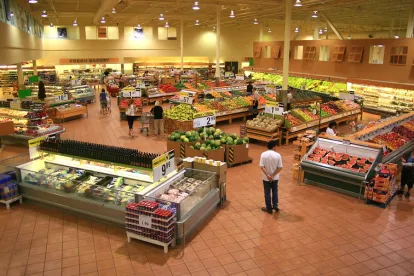In a retail world that is ever-changing, could the big four supermarket giants become the big three? Sainsbury’s and Yorkshire-based supermarket Asda (the second and third largest supermarkets in the UK) have announced they are at an ‘advanced’ stage in proposed merger talks. The merger could result in approximately 2,800 stores and represent over 30% of the UK grocery market. (Note that these figures are dependent on the Competition and Markets Authority review and so the eventual combined portfolio could be less).
The big supermarket brands have been trading outside the traditional food and drink market for some time, with supermarket giants becoming your ‘one stop shop’ for all things ranging from clothing and electrical goods to home furnishings. The leaders in the market are constantly looking for new sources of growth and ways to adapt to changing consumer demands.
Morrisons linked up with Amazon a couple of years ago to supply the online retailer with hundreds of products and it has also done a deal to supply McColl’s, the convenience store chain. Last year the Co-op completed a £143m takeover of Nisa and Sainsbury’s clinched the £1.4 billion acquisition of Argos. Tesco have recently completed the £3.7 billion acquisition of Booker, Britain’s biggest wholesaler, to tap into the ‘out of home’ food market where people are buying prepared food to eat at home or on the go.
Long gone are the days where you would visit a supermarket once a week for your provisions and it seems the ‘big shop’ visit could soon be a thing of the past. It has been reported that two-thirds of Britons now nip to a supermarket more than once a day, with one in ten people deciding what to buy for an evening meal just before they eat it, often stopping on the way home from work. With longer opening hours and more convenience stores and companies such as ‘Hello Fresh’ delivering specific meal ingredients to your door, are we moving towards a new trend of ‘as and when’ shopping? The Waitrose Food and Drink Report 2017 says consumers treat supermarkets like walk-in fridges. The Report also found that consumers have become more flexible in their shopping patterns, more price-savvy and more single-minded than ever before.
It is no secret that the industry has also been shaken-up by low-cost discounters such as Aldi and Lidl, with both chains recently reporting record new highs in market share of 7.3% and 5.3% respectively. Between them, they have taken over a 10% slice of the supermarket pie and they are continuing to thrive in a fierce market, even in times of competitive online shopping efficiency. The way in which people are shopping is evolving and in this post-Brexit referendum limbo, confidence is low and consumers are being savvier with their cash. It seems that whilst the supermarket giants have been quicker to adapt to the online market demand than the non-food retail industry, this alone is not enough in light of changing consumer needs and attitudes.
Whilst the proposed merger of Sainsbury’s and Asda is causing uncertainty in the market, Sainsbury’s has pledged to cut prices on everyday products following the deal which should only be good news for consumers. However, suppliers will be naturally concerned about who will foot these savings. There are concerns amongst the industry that the proposed merger will make life very difficult for smaller suppliers who are already battling in a very competitive environment. This is a challenging time in the grocery industry, with more stress factors and more competitors than ever before. Consumers want it all – convenience, efficiency and low prices. Battles are being won in the market – but who will win the war?





 />i
/>i

